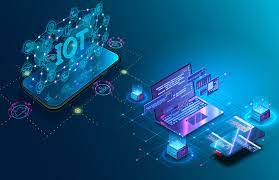IOT (Internet of Things) development involves designing and creating systems that connect physical devices, sensors, and actuators to the internet to enable data exchange and remote control. Here are the key steps involved in IoT development design:
- Identify Use Case and Objectives: Determine the purpose of your IoT project and identify the specific use case you want to address. Define your objectives, whether it’s improving efficiency, enhancing user experience, optimizing resource utilization, or creating new business opportunities.
- Device Selection: Select the appropriate devices and sensors that will collect data and interact with the physical environment. Consider factors such as connectivity (Wi-Fi, Bluetooth, cellular), power requirements, data storage, and compatibility with the existing infrastructure.
- Connectivity: Decide on the connectivity options for your IoT system. It can include Wi-Fi, Ethernet, cellular networks, or low-power wide-area networks (LPWAN) such as LoRaWAN or NB-IoT. Choose the connectivity technology based on factors like range, power consumption, data transfer speed, and cost.
- Data Collection and Communication: Determine how you will collect data from sensors and devices and how it will be transmitted to the cloud or a centralized server. This may involve protocols like MQTT (Message Queuing Telemetry Transport) or HTTP (Hypertext Transfer Protocol) for communication and APIs (Application Programming Interfaces) for data integration.
- Cloud Infrastructure: Establish the cloud infrastructure or a backend system to store and process the collected data. Choose a suitable cloud service provider or set up your own private cloud. Consider factors like scalability, security, data analytics capabilities, and integration with other systems.
- Data Analytics: Determine how the collected data will be analyzed to derive insights and enable informed decision-making. This can involve data visualization, machine learning algorithms, predictive analytics, or real-time monitoring. Identify the tools and techniques needed to extract valuable information from the data.
- User Interface and Applications: Design the user interface (UI) and applications that enable users to interact with the IoT system. This can include web or mobile applications, dashboards, or even voice interfaces. Ensure that the UI is intuitive, user-friendly, and provides relevant information and control options to the users.
- Security and Privacy: Implement robust security measures to protect the IoT system from unauthorized access, data breaches, and cyber-attacks. This includes authentication, encryption, secure data transfer, and regular security audits. Consider privacy concerns and compliance with data protection regulations.
- Testing and Validation: Thoroughly test the IoT system to ensure its reliability, functionality, and performance. Conduct integration testing, stress testing, and security testing. Validate the system against the defined objectives and use cases to ensure it meets the desired requirements.
- Deployment and Maintenance: Deploy the IoT system in the intended environment, whether it’s a commercial setting, industrial facility, or residential premises. Establish procedures for ongoing system maintenance, including monitoring, updates, and troubleshooting. Plan for scalability and future enhancements.
Remember that IoT development is a multidisciplinary process, involving hardware design, software development, networking, data analytics, and user experience. Collaboration among different teams, such as engineers, developers, data scientists, and designers, is crucial for successful IoT development and deployment.



